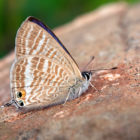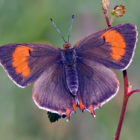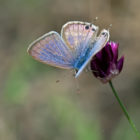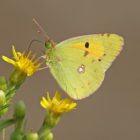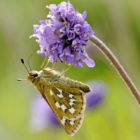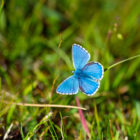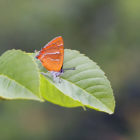Dates & Prices |
BOOK NOW |
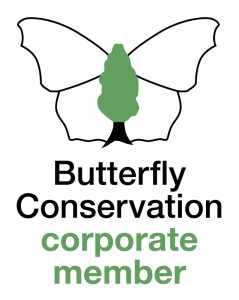
Date: Friday 15th August 2025 Confirmed departure
Price: £75 3 places
Price Includes: Services of the guide for the day 09:00 – 17:00, transport by minibus or similar
Not included: Lunch, drinks & snacks
Meeting place: Burgess Hill Train station
Leader: Kat Dahl & Terry Goble
Group Size: Minimum of 3 and a maximum of 12 guests plus 1-2 leaders
Conservation donation: Butterfly Conservation & the Steyning Downland Scheme
Holiday Highlights
- Enjoy a summer day out in Sussex for butterflies & other wildlife
- Led by local naturalist Kat Dahl (plus Terry Goble for a larger group)
- We will visit key locations to look for our main targets of Brown Hairstreak, Adonis Blue & Chalk-hill Blue
- Other butterfly highlights we may see include Silver-spotted Skipper, Wall Brown, Clouded Yellow, Common Blue, Brown Argus, and possibly Long-tailed Blue
- Relaxed pace to full appreciate the wildlife & for photography
- In support of Butterfly Conservation & the Steyning Downland Scheme
We invite you to join us for a summer day out in Sussex, looking for Brown Hairstreak, Silver-spotted Skipper, Adonis Blue, plus other butterflies!
 Your Guides
Your Guides

Kat Dahl is a passionate naturalist born and bred, with a particular interest in insects, especially moths and butterflies. She is a wildlife guide for the Knepp Wildland project in Sussex, specialising in tours for Purple Emperor and other butterflies, and she is also a Learning Officer with the Berks Bucks Oxon Wildlife Trust, teaching people of all ages about wildlife. She has been a member of the Upper Thames Butterfly Conservation committee and is a member of their Conservation and Recording Team, and is an iRecord verifier for Upper Thames butterflies. She is also a member of Berkshire and Sussex Moth Groups, and leads the moth surveying for the Steyning Downland Scheme, a landscape conservation project in Sussex.
Kat has worked on projects to protect turtles in Cyprus and rehabilitate Snow Leopards in Kyrgyzstan, but is happiest moth-trapping, butterfly-watching and caterpillar-hunting, and sharing the wonders of nature with others.

Terry Goble has undertaken voluntary work for the RSPB, Bat conservation Trust, Butterfly Conservation and fund raising for many wildlife charities. Later he studied for a degree in Environment and Conservation. During his degree years he focused on his passion for butterflies and studied the fluctuating populations of butterflies on the South Downs. He enjoyed tracking the spread of species such as Silver-spotted Skipper, but was alarmed at the decline of some much-loved species. He continues voluntary work to help restore habitat and conserve these precious but diminishing populations. After university Terry started to look to change his career and stumbled upon leading tours for wildlife holiday companies, which seemed to fit his profile of interests for travel, animals and of course people. Over the ensuing years he has now led many butterfly tours to Europe including Hungary, Croatia, Romania and Greece and has also enjoyed learning to identify butterflies in some more exotic locations. He has had the opportunity to unravel some of the myriad species of butterflies in the Americas, ‘glasswings’ being a particular favourite. He also very much enjoys sharing knowledge with others and is equally happy to learn from people as well.
Join us for a day out in Sussex, looking for Brown Hairstreak and other late summer butterflies.
West Sussex is a stronghold for the rare Brown Hairstreak and chalk grassland species such as Adonis Blue, Chalk-hill Blue and Silver-spotted Skipper.
We will spend the morning on the Steyning Downland Scheme, arguably the best site in Britain to see Brown Hairstreak, made famous by Patrick Barkham in his book, ‘The Butterfly Isles’. This wonderful community conservation project has some fantastic stands of Blackthorn, the Brown Hairstreak’s larval foodplant, which is carefully managed for this species. We should hopefully see males dancing about in the Ash and Sycamore trees, and maybe females either freshly emerged from their pupae or egg-laying in the Blackthorn. There are several other butterfly species here, including Common Blue, Brown Argus, Wall Brown and sometimes Clouded Yellow, and a wealth of dragonfly, bee and hoverfly species, as well as spectacular Wasp Spiders.
We will then spend the afternoon up on the chalk downs north of Brighton, amongst Adonis and Chalk-hill Blues and Silver-spotted Skippers. There are also several endemic species of flora to be found in this habitat, such as Autumn Lady’s Tresses orchids, Round-headed Rampion (also known as ‘The Pride of Sussex’) and Carline Thistle. Another highlight is the impressive Hornet Robberfly, Britain’s largest species of fly.
Generally speaking, the paths are good, but walking boots are recommended as the paths can be uneven and undermined by rabbit burrows. There are quite a few slopes involved, although the steepest can be traversed diagonally.
Event itinerary:
This day starts with meeting up at Burgess Hill Train Station, on the London to Brighton line. From here we will travel by minibus to the Steyning Downland Scheme, arguably the best site in Britain to see Brown Hairstreak, made famous by Patrick Barkham in his book, ‘The Butterfly Isles’. This wonderful community conservation project has some fantastic stands of Blackthorn, the Brown Hairstreak’s larval foodplant, which is carefully managed for this species. We should hopefully see males dancing about in the Ash and Sycamore trees, and maybe females either freshly emerged from their pupae or egg-laying in the Blackthorn. There are several other butterfly species here, including Common Blue, Brown Argus, Wall Brown and sometimes Clouded Yellow, and a wealth of dragonfly, bee and hoverfly species, as well as spectacular Wasp Spiders.
We will eat our lunch at this site. It will be possible to stop to purchase lunch and drinks on the way from Burgess Hill Train Station to Steyning.
We will then drive up onto the chalk downs north of Brighton and spend the afternoon amongst Adonis and Chalk-hill Blues and Silver-spotted Skippers. There are also several endemic species of flora to be found in this habitat, such as Autumn Lady’s Tresses orchids, Round-headed Rampion (also known as ‘The Pride of Sussex’) and Carline Thistle. Another highlight is the impressive Hornet Robberfly, Britain’s largest species of fly. There are facilities at this site.
We will then drive back to Burgess Hill Train Station.
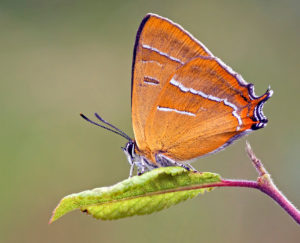



This day starts with meeting up at Burgess Hill Train Station, on the London to Brighton line. From here we will travel by minibus to the Steyning Downland Scheme, arguably the best site in Britain to see Brown Hairstreak, made famous by Patrick Barkham in his book, ‘The Butterfly Isles’. This wonderful community conservation project has some fantastic stands of Blackthorn, the Brown Hairstreak’s larval foodplant, which is carefully managed for this species. We should hopefully see males dancing about in the Ash and Sycamore trees, and maybe females either freshly emerged from their pupae or egg-laying in the Blackthorn. There are several other butterfly species here, including Common Blue, Brown Argus, Wall Brown and sometimes Clouded Yellow, and a wealth of dragonfly, bee and hoverfly species, as well as spectacular Wasp Spiders.
We will eat our lunch at this site. It will be possible to stop to purchase lunch and drinks on the way from Burgess Hill Train Station to Steyning.
We will then drive up onto the chalk downs north of Brighton and spend the afternoon amongst Adonis and Chalk-hill Blues and Silver-spotted Skippers. There are also several endemic species of flora to be found in this habitat, such as Autumn Lady’s Tresses orchids, Round-headed Rampion (also known as ‘The Pride of Sussex’) and Carline Thistle. Another highlight is the impressive Hornet Robberfly, Britain’s largest species of fly. There are facilities at this site.
We will then drive back to Burgess Hill Train Station.
- Long-tailed Blue
New trip – testimonials will appear later



